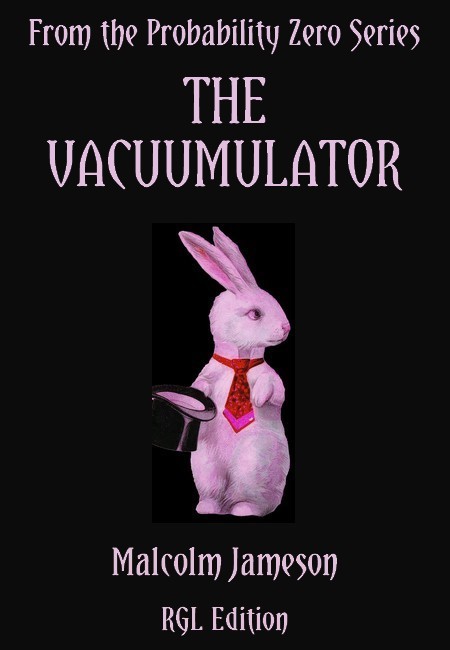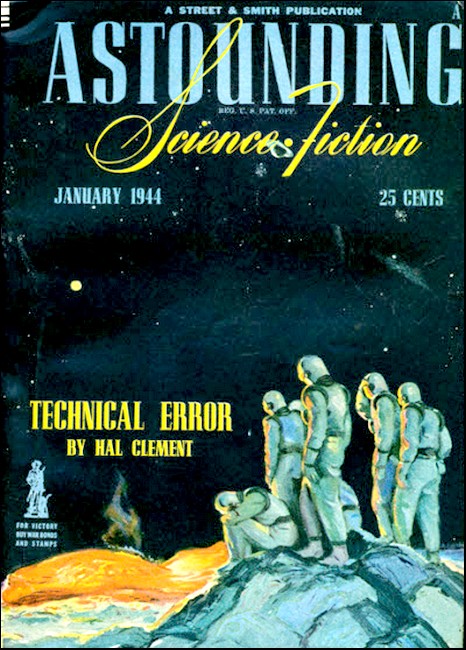
RGL e-Book Cover©
Roy Glashan's Library
Non sibi sed omnibus
Go to Home Page
This work is out of copyright in countries with a copyright
period of 70 years or less, after the year of the author's death.
If it is under copyright in your country of residence,
do not download or redistribute this file.
Original content added by RGL (e.g., introductions, notes,
RGL covers) is proprietary and protected by copyright.

RGL e-Book Cover©


Astounding Science-Fiction, January 1944, with "The Vacuumulator"
IN April 1942 Astounding Science-Fiction launched an open-ended series of "tall stories" under the general title "Probability Zero!" Writers were invited to submit contributions as entries in a competition, with prize money going to the first-, second- and third-placed stories each month.
The first three items published in the new series were: "Some Curious Effects of Time Travel," by Sprague de Camp; "Pig Trap," by Malcolm Jameson; and "Time Pussy," by George E. Dale.
Following the third item, the Editor printed the following description of the new series:
... The little items preceding were concocted, of course, by a sound trio of first-class, professional liars. In a length of this sort—some five hundred to seven hundred and fifty words—I think that there ought to be a number of excellent amateur liars, though. There may or may not be a "Probability Zero" department next month; the succeeding issue, however, will certainly have one—one concocted by amateurs and professionals alike. This month's supply of examples were bought at our standard space-rates; hereafter "Probability Zero" will be conducted as an open contest, wherein anyone equipped with a good, round prevarication is welcome. Readers will be invited to vote for the best of those published; the author of the winner will get twenty dollars, second place acquires ten, and third gets our check for five. Checks will be mailed as soon as the issue is decided.
To define the essence of the thing: We want science-fictional masterpieces that sound almost possible, but which are, as the department title states, "Probability Zero"—impossible by reason of known scientific law or by definition. They must be typed, double-spaced, and on one side of the usual size typewriter paper.
The old gag about truth being stranger than fiction is founded soundly; many an actual truth is highly implausible. We're looking for the exact reverse-something that's absolutely untrue, but highly plausible sounding.
For instance, it's a fact that a powerful jet of air—a real, roaring blast of air—will not blow a ball away; it will hold even a solid, fairly dense ball like a billiard ball supported in midair, pulling it back into the hardest, fastest part of the air-blast if it tries to waver out. That is obviously implausible; it happens to be true. It is also true that if you have a rope or chain running rapidly over two pulleys, with a considerable amount of slack in the chain, you can bend the chain's course into a loop—and have the loop stay there after removing the original deflecting force. The rapidly-moving chain will faithfully trace a course around the obstacle long after it has been removed, following a complicated S-course, even though under considerable tension. That's a rather implausible fact.
If facts can be that implausible, a good plausible lie should be fairly easy.
Click here to access a detailed bibliography of the Probability Zero! series in the Internet Speculative Fiction Database.
—Roy Glashan, 30 March 2022

PROFESSOR GNITWITT beamed in triumph on his visitors.
"Yes," he chortled, "this is it—the machine that will make a perfect vacuum. Inspect it!"
They inspected it, frowning, muttering, stroking beards or massaging bald pates. It was undoubtedly a weird contraption. It resembled a bathysphere-in being a ruggedly built sphere, in one side of which there was a lensed window with a sliding cover. At its top there was a small gooseneck vent pipe in whose stem there was a check valve. Nearby stood a battery of powerful arclights focused on the aperture in the vacuumulator. A glance at a diagram hanging on the wall told them that the sphere was hollow, its only internal feature being that it was lined with a myriad of faceted mirrors.
Professor Gnitwitt passed around dark glasses. Then he reached for the switch and turned on the lights.
"The vacuumulator is at present filled with air. I illuminate it in the ordinary way. I increase the illumination and the light pressure until the sphere is filled with light. See?"
No one could: the lights were blinding.
"Now," went on the triumphant Gnitwitt, "since it is filled with light there can be no room for air. That has escaped by means of the relief valve at the top, but the vent being goosenecked and also lined with black velvet prevents any of the light from escaping. Therefore we have replaced the air by light. We shut oft' the light. Now there is nothing. Q.E.D.!"
"Not for my money," snorted Dr. U. Wood. "You closed the entry port, true enough, but the sphere is still full of light. By your own assertion, no light can escape. It is still in there, bouncing from mirror to mirror."
"Precisely."
Now Professor Gnitwitt was triumphant.
"You forget Short's Law of Light," he hurled at him, disdainfully. "According to Short, light is slowed, dissipated and weakened by its many rapid journeys back and forth and the wear and tear on it of so many abrupt reversals. It lags, it reddens, it dims. It—to be brief, my learned colleague—it tires! It lies down. It quits. And when light quits, you have nothing. We have, in Short, a vacuum."
Roy Glashan's Library
Non sibi sed omnibus
Go to Home Page
This work is out of copyright in countries with a copyright
period of 70 years or less, after the year of the author's death.
If it is under copyright in your country of residence,
do not download or redistribute this file.
Original content added by RGL (e.g., introductions, notes,
RGL covers) is proprietary and protected by copyright.